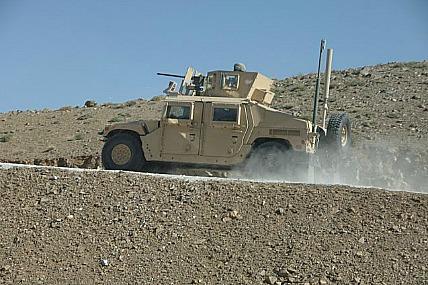The Army Reserve has about 86 percent of the equipment it's supposed to have on hand. But that equipment is only 66 percent modernized. That's a problem for keeping Reserve Soldiers trained, and for keeping up morale, said its commander.
"The equipment we have in a lot of cases is substitute items for the modern equipment," said Lt. Gen. Jack C. Stultz, chief, Army Reserve, and commander of the U.S. Army Reserve Command. "As far as our Soldiers being able to do their jobs in Afghanistan and Iraq and other places, (it's) not an issue. We make sure they are using modernized equipment in those theaters; where it impacts me is back home."
Stultz, along with Lt. Gen. William E. Ingram Jr., director, Army National Guard, testified May 23 on Capitol Hill before the Senate Appropriations Committee, subcommittee on defense.
Stultz had been asked about equipment modernization, and how much equipment the Army Reserve has on hand. He said while the Army Reserve has modernized equipment in theater, it's back at home, where home-station training occurs, that he sees a problem.
"It impacts me back home because now, and especially since we've drawn out of Iraq and we are going to start drawing down out of Afghanistan, I am focusing on home-station training," Stultz said. "How do I keep these Soldiers trained at home so they are ready to go when I need them?"
It's also a morale issue for Soldiers, Stultz said. When a Soldier has been in theater and uses the modern equipment there during operations, and then returns home to his unit for training and sees outdated equipment, he loses interest.
"It does have an impact on the Soldier who is saying 'why aren't we training on what we just had in Afghanistan?'" Stultz said. "So to me, the modernization of that equipment is critical for our retention and for our readiness."
HUMVEE RECAP OR JLTV?
Ingram said that when it comes to Humvees, for instance, the Army National Guard has to strike a balance between spending money on recapitalizing outdated Humvees, or waiting for the Joint Light Tactical Vehicle to be fielded to units.
"We have some of the oldest Humvees in the inventory for the Army," Ingram told lawmakers. "The question is do we keep a number of Humvees, un-recapitalized, to trade in or to turn in as we gain the JLTV? It's a balance. Obviously, we would like to upgrade the fleet. But we want to be frugal with our resources and do the right thing. So at the moment there is a tradeoff there. The longer we wait, the older the vehicles become and the more need there is for newer vehicles or for recap."
Stultz said he has concerns about modernization plans for the Army Reserve. In particular, as the Army draws down its end strength, units might be shuttered. Equipment from those units, he said, might cascade into the Army Reserve.
"I think (restructuring) is going to lead us to make some equipping decisions for the future that might say we can delay some modernization until we decide what the force structure will look like," Stultz said. "I can't afford to wait. My Soldiers need equipment today."
While Stultz agreed it's probably "a smart thing to do in some cases," he also told lawmakers that it could be several years before Army Reserve units see equipment coming out of active units.
"That is why the National Guard and Reserve Equipment Account funding that you give us is so critical," Stultz said. "Because if the Army says we are not going to buy anymore modernized trucks, for instance, because we are probably going to take some of the active trucks and give them to you in 2016, I can go ahead and buy some today, and put them in my units. And then when the other ones come, fill out the rest of my units."
STRATEGIC TO OPERATIONAL
"The Army Reserve today is an operational force, and it is highly successful," Stultz told senators.
The general said the Army Reserve's effort to convert from a strategic "weekend warrior" force, to an operational force has gone as planned.
"During the period of Operation Iraqi Freedom, or OIF and Operation Enduring Freedom, also known as OEF, the Army Reserve has mobilized over 200,000 of our Soldiers and put them into support missions both in Iraq and Afghanistan, and here at home," Stultz said. "We have continually kept on active duty somewhere between 20-30,000 Soldiers every day since that inception. Those Soldiers are doing critical missions."
Those critical enabling missions include engineer, medical, logistics, transportation and military police, for instance. He said the active Army has shifted those responsibilities into the reserve component. Today, he said, for 85 percent of transportation support, 70 percent of medical support, and 85 percent of civil affairs and psychological operations support comes from Army National Guard and Army Reserve Soldiers.
"The Army can't do what they do without us," Stultz said. "That transformation has been hugely successful. It's not the leadership I have given, it's the dedication our Soldiers have given. The culture of the Army Reserve has changed. Soldiers that are in the Army Reserve today either have joined our force or re-enlisted to stay in our force while this nation is at war. They know what they signed up for."


























